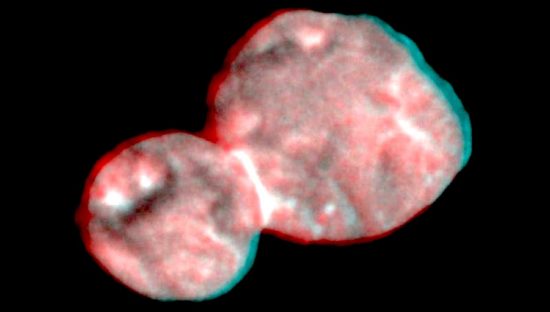
Jan 7, 2019
New Horizons recently flew by the most distant object imaged by any spacecraft.
The Kuiper Belt theory is the creation of astronomer Kenneth Edgeworth from Ireland and also, separately, by American astronomer Gerard Kuiper in 1951. The first Kuiper Belt Object (KBO) was discovered in 1992. Sometimes known as “trans-Neptunian Objects”, dozens of KBOs the size of small moon-sized planets have recently been discovered.
NASA launched the New Horizons spacecraft on January 19, 2006. As Picture of the Day readers recall, New Horizons provided confirmation of Electric Universe principles when it flew by the Pluto/Charon system on July 14, 2015. On January 1, 2019 New Horizons flew by a remote object near the edge of the Kuiper Belt recently named, “Ultima Thule”.
At flyby time, Ultima Thule was about 6.5 billion kilometers from the Sun, making this the most distant planetary flyby, and the first time that an object like it was seen close-up. Ultima Thule is approximately 30 kilometers in diameter, with an irregular shape. Ultima Thule is described as a “contact binary”, and is similar in shape to Comet 67P/Churyumov-Gerasimenko.
One immediate piece of information is that Ultima Thule has a reddish color, probably caused by tholin compounds that were discussed in previous Picture of the Day articles. Tholins are large organic molecules that arise when ultraviolet light interacts with smaller molecules. They cannot exist naturally on Earth, because atmospheric oxygen would quickly destroy them. They can be synthesized in laboratory isolation, however, by sending electric arcs through various combinations of methane and ammonia.
Tholins are primarily a rusty color, which could help to explain the reddish-orange hue of Titan’s atmosphere, where there is almost no oxygen. The Cassini spacecraft detected “large molecules” when it flew within 800 kilometers of Titan’s surface. The molecules remain unknown, however, because Cassini did not carry the necessary instruments.
It is not a coincidence that electric arcs are used to create tholins in the laboratory. The Huygens probe found high concentrations of charged particles in the lower atmosphere of Titan, so intense electrical activity could have been responsible for the formation of organic molecules there, as well. Perhaps the reddish-brown “soot” that covers Ultima Thule contains tholins.
Data acquisition from New Horizons is currently suspended, with complete reception of all information scheduled to arrive over the next two years.
Stephen Smith












